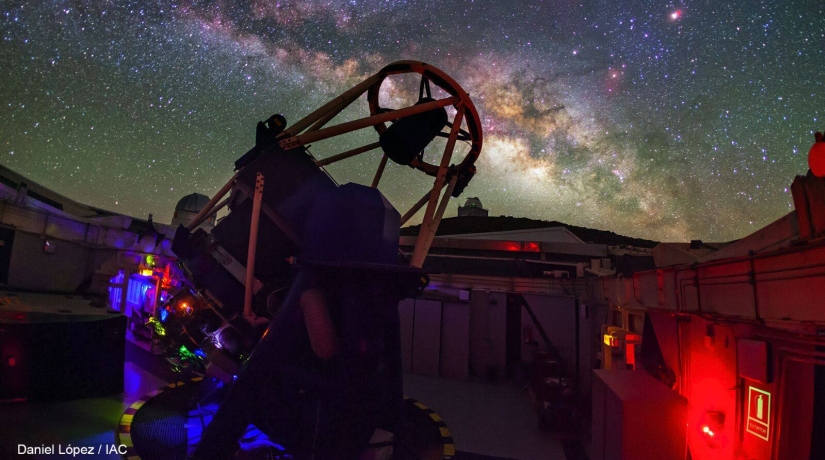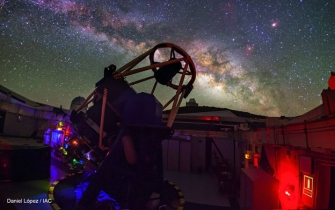
The autonomous fully robotic Liverpool Telescope located on the Canary Islands, Spain is now part of the GROWTH global network of observatories.
2017
30 MarchLiverpool John Moores University joins the GROWTH partnership
Following the signing of a Memorandum of Understanding (MoU) on Wednesday, March 29, the Astrophysics Research Institute (ARI) at Liverpool John Moores University (LJMU) in the UK officially became the 14th partner in the GROWTH scientific collaboration. As part of GROWTH, researchers from LJMU will expand research on novae, and particularly their role as potential progenitors of Type Ia supernovae. The fully robotic Liverpool Telescope (LT), operated by the ARI will also join the GROWTH global network of observatories providing additional follow-up resources for the search of electromagnetic counterpart to gravitational wave sources.
The unique follow-up provided by GROWTH and the unparalleled rapid response of the LT are vital to the discovery and exploitation of the new fields of faint fast novae and rapidly recurring novae. Possibly one and the same, these phenomena may be key to the link between novae and type Ia supernovae
says Matt Darnley, Reader in Time Domain Astrophysics at LJMU.
We are tremendously excited to joint GROWTH and are looking forward to combining our considerable efforts and resources in the search for gravitational wave counterparts. Watch this space!”-
says Iain Steele, Director of LJMU's Liverpool Telescope.
The unique strength of the GROWTH collaboration stems from the coordinated efforts of international teams and facilities to respond to triggers from discovery engines such as LIGO in almost real time, and observe seamlessly fast-changing transient events round the clock. Such ability for rapid follow-up is critical in discovering the predicted electromagnetic signatures from the merging on two neutron stars or a neutron star and a black hole. Astronomers have not yet seen the radiation from such mergers and many believe it carries the answer to a long-standing mystery of how elements heavier than iron form in the Universe.
We are very excited that LJMU has joined the GROWTH team. Finding the cosmic mines of heavy elements is especially tough as the flash of light may fade away in a few hours. Located in the Canary Islands, Spain, the LT is perfectly positioned to follow-up fading transients initially found in California
says Mansi Kasliwal, GROWTH principal investigator and an assistant professor at Caltech.
The signing of the GROWTH MoU with Caltech is fantastic news for future research in time-domain astrophysics at the ARI. The new partnership will help provide the electromagnetic identification of gravitational wave sources and determine the properties of the most powerful stellar explosions in astrophysics, in addition to other projects.
adds Prof Chris Collins, head of the Astrophysics Research Institute.
Partners at LJMU are also eager to welcome students and young researchers as part of the GROWTH Graduate/Postdoc Exchange Program and the Summer Research Program, designed for undergraduates. Last year, Caltech student Kit Chinetti spent her summer at the ARI working with Matt Darnley and Paolo Mazzali on discovery and classification of novae in the Andromeda Galaxy. During the summer project, she discovered a nova in the outskirts of Andromeda galaxy and wrote her first post to the Astronomer’s Telegram (ATel) – an online platform for announcements of discoveries of transient events to the global astronomical community.
Working with students like Kit is very rewarding. I look forward to welcoming more GROWTH students next year
says Prof Paolo Mazzali who was one of Kit’s mentors.
It’s our priority to work closely with our US colleagues to enhance the student experience of research. Under the new agreement LJMU and Caltech students will spend time at the partner university, where they will benefit from access to new facilities and expertise, and have the opportunity to engage with science research that has fundamental implications for our understanding of gravity and dark energy.
adds Prof Collins.
I left Caltech to join LJMU but in science you never really quite leave. I’m glad that through GROWTH, I can to continue to collaborate with colleagues in Caltech and across the world
says Daniel Perley, now Senior Lecturer at LJMU.
More Information
Formal partners from LJMU in GROWTH are Chris Copperwheat, Matt Darnley, Paolo Mazzali, Daniel Perley, and Iain Steele.
The Liverpool Telescope is a fully autonomous robotic telescope located at the international Observatorio del Roque de los Muchachos on the summit of the island of La Palma (Canaries), some 200 km off the coast of northwest Africa. The telescope is designed to enable scientific studies of the dynamic cosmos by rapid robotic reaction to unpredictable phenomena and their systematic follow-up, monitoring of variable objects on all timescales from seconds to years, and simultaneous coordinated observations with other ground and space based facilities. The LT is owned and operated by the ARI of LJMU in northwest England.
Related Links
Spacepod Podcast: Celescial Cinematography with GROWTH
Student Opportunities with GROWTH
Youtube: Liverpool Telescope
GROWTH undergraduate student makes her first discovery of a cosmic explosion in a far corner of the Andromeda Galaxy
Contact
Iva Kostadinova
GROWTH Communications and Media Contact
ivonata@caltech.edu
+1 626 395 2952
Clare Coombes
Media Relations and Public Affairs Officer at Liverpool John Moores University
C.N.Coombes@ljmu.ac.uk




